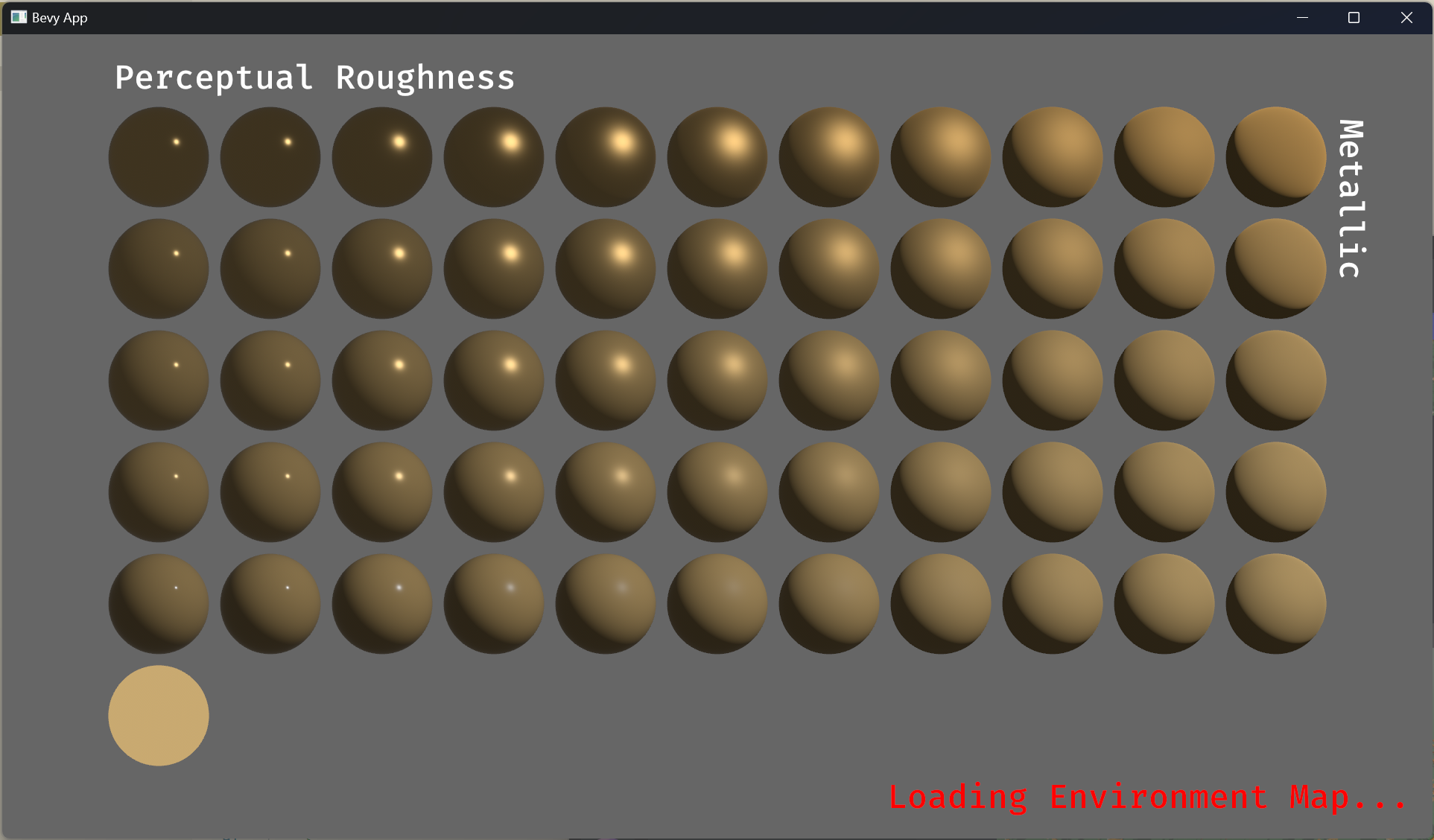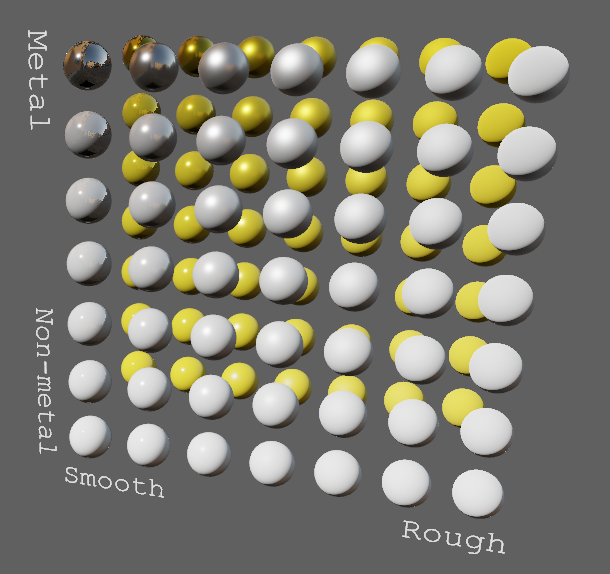# Objective
This pull request implements *reflection probes*, which generalize
environment maps to allow for multiple environment maps in the same
scene, each of which has an axis-aligned bounding box. This is a
standard feature of physically-based renderers and was inspired by [the
corresponding feature in Blender's Eevee renderer].
## Solution
This is a minimal implementation of reflection probes that allows
artists to define cuboid bounding regions associated with environment
maps. For every view, on every frame, a system builds up a list of the
nearest 4 reflection probes that are within the view's frustum and
supplies that list to the shader. The PBR fragment shader searches
through the list, finds the first containing reflection probe, and uses
it for indirect lighting, falling back to the view's environment map if
none is found. Both forward and deferred renderers are fully supported.
A reflection probe is an entity with a pair of components, *LightProbe*
and *EnvironmentMapLight* (as well as the standard *SpatialBundle*, to
position it in the world). The *LightProbe* component (along with the
*Transform*) defines the bounding region, while the
*EnvironmentMapLight* component specifies the associated diffuse and
specular cubemaps.
A frequent question is "why two components instead of just one?" The
advantages of this setup are:
1. It's readily extensible to other types of light probes, in particular
*irradiance volumes* (also known as ambient cubes or voxel global
illumination), which use the same approach of bounding cuboids. With a
single component that applies to both reflection probes and irradiance
volumes, we can share the logic that implements falloff and blending
between multiple light probes between both of those features.
2. It reduces duplication between the existing *EnvironmentMapLight* and
these new reflection probes. Systems can treat environment maps attached
to cameras the same way they treat environment maps applied to
reflection probes if they wish.
Internally, we gather up all environment maps in the scene and place
them in a cubemap array. At present, this means that all environment
maps must have the same size, mipmap count, and texture format. A
warning is emitted if this restriction is violated. We could potentially
relax this in the future as part of the automatic mipmap generation
work, which could easily do texture format conversion as part of its
preprocessing.
An easy way to generate reflection probe cubemaps is to bake them in
Blender and use the `export-blender-gi` tool that's part of the
[`bevy-baked-gi`] project. This tool takes a `.blend` file containing
baked cubemaps as input and exports cubemap images, pre-filtered with an
embedded fork of the [glTF IBL Sampler], alongside a corresponding
`.scn.ron` file that the scene spawner can use to recreate the
reflection probes.
Note that this is intentionally a minimal implementation, to aid
reviewability. Known issues are:
* Reflection probes are basically unsupported on WebGL 2, because WebGL
2 has no cubemap arrays. (Strictly speaking, you can have precisely one
reflection probe in the scene if you have no other cubemaps anywhere,
but this isn't very useful.)
* Reflection probes have no falloff, so reflections will abruptly change
when objects move from one bounding region to another.
* As mentioned before, all cubemaps in the world of a given type
(diffuse or specular) must have the same size, format, and mipmap count.
Future work includes:
* Blending between multiple reflection probes.
* A falloff/fade-out region so that reflected objects disappear
gradually instead of vanishing all at once.
* Irradiance volumes for voxel-based global illumination. This should
reuse much of the reflection probe logic, as they're both GI techniques
based on cuboid bounding regions.
* Support for WebGL 2, by breaking batches when reflection probes are
used.
These issues notwithstanding, I think it's best to land this with
roughly the current set of functionality, because this patch is useful
as is and adding everything above would make the pull request
significantly larger and harder to review.
---
## Changelog
### Added
* A new *LightProbe* component is available that specifies a bounding
region that an *EnvironmentMapLight* applies to. The combination of a
*LightProbe* and an *EnvironmentMapLight* offers *reflection probe*
functionality similar to that available in other engines.
[the corresponding feature in Blender's Eevee renderer]:
https://docs.blender.org/manual/en/latest/render/eevee/light_probes/reflection_cubemaps.html
[`bevy-baked-gi`]: https://github.com/pcwalton/bevy-baked-gi
[glTF IBL Sampler]: https://github.com/KhronosGroup/glTF-IBL-Sampler
# Objective
- `deferred_rendering` and `load_gltf` fail in WebGPU builds due to
textureSample() being called on the diffuse environment map texture
after non-uniform control flow
## Solution
- The diffuse environment map texture only has one mip, so use
`textureSampleLevel(..., 0.0)` to sample that mip and not require UV
gradient calculation.
# Objective
Even at `reflectance == 0.0`, our ambient and environment map light
implementations still produce fresnel/specular highlights.
Such a low `reflectance` value lies outside of the physically possible
range and is already used by our directional, point and spot light
implementations (via the `fresnel()` function) to enable artistic
control, effectively disabling the fresnel "look" for non-physically
realistic materials. Since ambient and environment lights use a
different formulation, they were not honoring this same principle.
This PR aims to bring consistency to all light types, offering the same
fresnel extinguishing control to ambient and environment lights.
Thanks to `@nathanf` for [pointing
out](https://discord.com/channels/691052431525675048/743663924229963868/1164083373514440744)
the [Filament docs section about
this](https://google.github.io/filament/Filament.md.html#lighting/occlusion/specularocclusion).
## Solution
- We use [the same
formulation](ffc572728f/crates/bevy_pbr/src/render/pbr_lighting.wgsl (L99))
already used by the `fresnel()` function in `bevy_pbr::lighting` to
modulate the F90, to modulate the specular component of Ambient and
Environment Map lights.
## Comparison
⚠️ **Modified version of the PBR example for demo purposes, that shows
reflectance (_NOT_ part of this PR)** ⚠️
Also, keep in mind this is a very subtle difference (look for the
fresnel highlights on the lower left spheres, you might need to zoom in.
### Before
<img width="1392" alt="Screenshot 2023-10-18 at 23 02 25"
src="https://github.com/bevyengine/bevy/assets/418473/ec0efb58-9a98-4377-87bc-726a1b0a3ff3">
### After
<img width="1392" alt="Screenshot 2023-10-18 at 23 01 43"
src="https://github.com/bevyengine/bevy/assets/418473/a2809325-5728-405e-af02-9b5779767843">
---
## Changelog
- Ambient and Environment Map lights will now honor values of
`reflectance` that are below the physically possible range (⪅ 0.35) by
extinguishing their fresnel highlights. (Just like point, directional
and spot lights already did.) This allows for more consistent artistic
control and for non-physically realistic looks with all light types.
## Migration Guide
- If Fresnel highlights from Ambient and Environment Map lights are no
longer visible in your materials, make sure you're using a higher,
physically plausible value of `reflectance` (⪆ 0.35).
# Objective
- bump naga_oil to 0.10
- update shader imports to use rusty syntax
## Migration Guide
naga_oil 0.10 reworks the import mechanism to support more syntax to
make it more rusty, and test for item use before importing to determine
which imports are modules and which are items, which allows:
- use rust-style imports
```
#import bevy_pbr::{
pbr_functions::{alpha_discard as discard, apply_pbr_lighting},
mesh_bindings,
}
```
- import partial paths:
```
#import part::of::path
...
path::remainder::function();
```
which will call to `part::of::path::remainder::function`
- use fully qualified paths without importing:
```
// #import bevy_pbr::pbr_functions
bevy_pbr::pbr_functions::pbr()
```
- use imported items without qualifying
```
#import bevy_pbr::pbr_functions::pbr
// for backwards compatibility the old style is still supported:
// #import bevy_pbr::pbr_functions pbr
...
pbr()
```
- allows most imported items to end with `_` and numbers (naga_oil#30).
still doesn't allow struct members to end with `_` or numbers but it's
progress.
- the vast majority of existing shader code will work without changes,
but will emit "deprecated" warnings for old-style imports. these can be
suppressed with the `allow-deprecated` feature.
- partly breaks overrides (as far as i'm aware nobody uses these yet) -
now overrides will only be applied if the overriding module is added as
an additional import in the arguments to `Composer::make_naga_module` or
`Composer::add_composable_module`. this is necessary to support
determining whether imports are modules or items.
# Objective
operate on naga IR directly to improve handling of shader modules.
- give codespan reporting into imported modules
- allow glsl to be used from wgsl and vice-versa
the ultimate objective is to make it possible to
- provide user hooks for core shader functions (to modify light
behaviour within the standard pbr pipeline, for example)
- make automatic binding slot allocation possible
but ... since this is already big, adds some value and (i think) is at
feature parity with the existing code, i wanted to push this now.
## Solution
i made a crate called naga_oil (https://github.com/robtfm/naga_oil -
unpublished for now, could be part of bevy) which manages modules by
- building each module independantly to naga IR
- creating "header" files for each supported language, which are used to
build dependent modules/shaders
- make final shaders by combining the shader IR with the IR for imported
modules
then integrated this into bevy, replacing some of the existing shader
processing stuff. also reworked examples to reflect this.
## Migration Guide
shaders that don't use `#import` directives should work without changes.
the most notable user-facing difference is that imported
functions/variables/etc need to be qualified at point of use, and
there's no "leakage" of visible stuff into your shader scope from the
imports of your imports, so if you used things imported by your imports,
you now need to import them directly and qualify them.
the current strategy of including/'spreading' `mesh_vertex_output`
directly into a struct doesn't work any more, so these need to be
modified as per the examples (e.g. color_material.wgsl, or many others).
mesh data is assumed to be in bindgroup 2 by default, if mesh data is
bound into bindgroup 1 instead then the shader def `MESH_BINDGROUP_1`
needs to be added to the pipeline shader_defs.
# Objective
- Closes https://github.com/bevyengine/bevy/issues/8008
## Solution
- Add a skybox plugin that renders a fullscreen triangle, and then
modifies the vertices in a vertex shader to enforce that it renders as a
skybox background.
- Skybox is run at the end of MainOpaquePass3dNode.
- In the future, it would be nice to get something like bevy_atmosphere
built-in, and have a default skybox+environment map light.
---
## Changelog
- Added `Skybox`.
- `EnvironmentMapLight` now renders in the correct orientation.
## Migration Guide
- Flip `EnvironmentMapLight` maps if needed to match how they previously
rendered (which was backwards).
---------
Co-authored-by: Robert Swain <robert.swain@gmail.com>
Co-authored-by: robtfm <50659922+robtfm@users.noreply.github.com>
# Objective
- Fix the environment map shader not working under webgl due to textureNumLevels() not being supported
- Fixes https://github.com/bevyengine/bevy/issues/7722
## Solution
- Instead of using textureNumLevels(), put an extra field in the GpuLights uniform to store the mip count
(Before)

(After)


# Objective
- Improve lighting; especially reflections.
- Closes https://github.com/bevyengine/bevy/issues/4581.
## Solution
- Implement environment maps, providing better ambient light.
- Add microfacet multibounce approximation for specular highlights from Filament.
- Occlusion is no longer incorrectly applied to direct lighting. It now only applies to diffuse indirect light. Unsure if it's also supposed to apply to specular indirect light - the glTF specification just says "indirect light". In the case of ambient occlusion, for instance, that's usually only calculated as diffuse though. For now, I'm choosing to apply this just to indirect diffuse light, and not specular.
- Modified the PBR example to use an environment map, and have labels.
- Added `FallbackImageCubemap`.
## Implementation
- IBL technique references can be found in environment_map.wgsl.
- It's more accurate to use a LUT for the scale/bias. Filament has a good reference on generating this LUT. For now, I just used an analytic approximation.
- For now, environment maps must first be prefiltered outside of bevy using a 3rd party tool. See the `EnvironmentMap` documentation.
- Eventually, we should have our own prefiltering code, so that we can have dynamically changing environment maps, as well as let users drop in an HDR image and use asset preprocessing to create the needed textures using only bevy.
---
## Changelog
- Added an `EnvironmentMapLight` camera component that adds additional ambient light to a scene.
- StandardMaterials will now appear brighter and more saturated at high roughness, due to internal material changes. This is more physically correct.
- Fixed StandardMaterial occlusion being incorrectly applied to direct lighting.
- Added `FallbackImageCubemap`.
Co-authored-by: IceSentry <c.giguere42@gmail.com>
Co-authored-by: James Liu <contact@jamessliu.com>
Co-authored-by: Rob Parrett <robparrett@gmail.com>